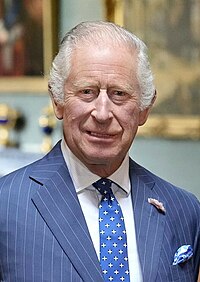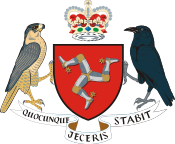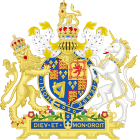Lord of Mann
| Lord of Mann | |
|---|---|
 | |
| Incumbent | |
 | |
| Charles III since 8 September 2022 | |
| Details | |
| Style | His Majesty |
| First monarch | George III |
| Formation | 1504 |
 |
|---|
The Lord of Mann (
Relationship with the Crown
Since 1399, the
The title "lord" was used by
The formal Latin style is Dominus Manniae.
List
Before 1504
Before 1504, the ruler of the Isle of Man was generally
16th century
- Thomas, Earl of Derby, 1504–1521
- Edward, Earl of Derby, 1521–1572
- Henry, Earl of Derby, 1572–1593
- Ferdinando, Earl of Derby, 1593–1594
Succession dispute (1594–1607)
In 1598, a succession dispute between the daughters of
The Queen, in consideration of the "many eminent services performed to herself and to her royal predecessors by the honourable and noble House of Stanley", withdrew her right and referred the contending claimants to the decision of the Privy Council as to the best claim of inheritance.
The Privy Council decided "the grant being by letters patent under the Great Seal of England, such right would descend according to the Common Law of England to the heirs general, and not to the heirs male", and the island was therefore awarded to Ferdinando's daughters; whereupon William agreed to purchase their several shares and interests.[9]
Interim (1607–1609)
Following the resolution of the succession dispute, it was ruled that the daughters of Ferdinando Stanley were the rightful heirs. As the oldest of them would not reach the
- Henry, Earl of Northampton, 1607–1608
- Robert, Earl of Salisbury, 1608–1609
| Assurance of the Isle of Man Act 1609 | |
|---|---|
| Act of Parliament | |
 7 Jas. 1. c. 4 | |
| Dates | |
| Repealed | 25 July 1991 |
| Other legislation | |
| Repealed by | Statute Law Revision (Isle of Man) Act 1991 |
Status: Repealed | |
| Text of statute as originally enacted | |
The original letters patent having been declared void, the
17th and 18th centuries
- William Stanley, 6th Earl of Derby, 1609–1612
- Elizabeth de Vere, Countess of Derby, 1612–1627
- James Stanley, 7th Earl of Derby, 1627–1651 (known as the Great Stanley)
- English Interregnum)
- Charles Stanley, 8th Earl of Derby, 1660–1672 (restored by King Charles II)
- William Richard George Stanley, 9th Earl of Derby, 1672–1702
- James Stanley, 10th Earl of Derby, 1702–1736
- James Murray, 2nd Duke of Atholl, 1736–1764
- Charlotte, Duchess of Atholl and John, Duke of Atholl, 1764–1765
In 1736, on the death of James Stanley, 10th Earl of Derby, the Duke of Atholl, a maternal grandson of James Stanley, 7th Earl of Derby, succeeded to the sovereignty of the Isle of Man, while a more distant cousin succeeded as Earl of Derby.
Revestment
In 1765,
- George III, 1765–1820
- George IV, 1820–1830
- William IV, 1830–1837
- Victoria, 1837–1901
- Edward VII, 1901–1910
- George V, 1910–1936
- Edward VIII, 1936
- George VI, 1936–1952
- Elizabeth II, 1952–2022
- Charles III, since 2022
In 1828, all remaining property interests and rights of the
Lieutenant governor
The Lord of Mann is now represented by the
See also
- Governor of the Isle of Man
- History of the Isle of Man
- Isle of Man Purchase Act 1765
- Lieutenant Governor of the Isle of Man
- Noble and royal titles of the Isle of Man
- List of Manx royal consorts
References
- ^ "Tynwald of Today". Tynwald. Archived from the original on 3 December 2008.
- ^ "A new electorate for the Isle of Man". BBC News. 19 November 2006. Retrieved 11 May 2010.
- ^ "Isle of Man". The official website of The British Monarchy. Archived from the original on 29 October 2013. Retrieved 27 October 2013.
- ^ "Proclamation of King Charles III, Lord of Mann". Youtube. Gef the Mongoose. Retrieved 14 October 2022.
- ^ Callow, Edward (1899). "Preface". From King Orry to Queen Victoria: A Short and Concise History of the Isle of Man. London, UK: Elliot Stock. Retrieved 27 October 2013 – via Isle-of-man.com.
- ^ "Kings & Lords of Mann". Manx National Heritage. Archived from the original on 30 May 2007.
- ISBN 978-1-4326-8295-8.
- Gell, James(ed.). An Abstract of the Laws, Customs, and Ordinances of the Isle of Man. Douglas: The Manx Society. Retrieved 27 October 2013 – via Isle-of-man.com.
- ^ "William, Sixth Earl of Derby, 1610-1627". Isle-of-man.com. Retrieved 27 October 2013.
- ^ Oliver, J.R., ed. (1861). "Grant of the Isle of Man to the Earl of Northampton and the Earl of Salesbury". Monumenta de Insula Manniae. Vol. III. Douglas: Manx Society. p. 88. Retrieved 27 October 2013 – via Isle-of-man.com.
- ^ Mills, M.A. (1821). "An Acte for the Assuringe and Establishing of the Isle of Manne". Ancient Ordinances and Statute Laws of the Isle of Man. Douglas. pp. 522–527 – via Isle-of-man.com.
- ^ Mills, M.A. (1821). "Grant by James I of Island to Earl of Salisbury". Ancient Ordinances and Statute Laws of the Isle of Man. Douglas. pp. 514–522 – via Isle-of-man.com.
- ^ Howe, David (30 November 2007). "Letter from The King of Mann". Manx Independent. Archived from the original on 14 December 2007. Retrieved 22 December 2007.
- ^ "Currency converter". The National Archives. Retrieved 6 July 2012.
- ^ "Act of Revestment 1765". Isle-of-man.com. Retrieved 27 October 2013.


